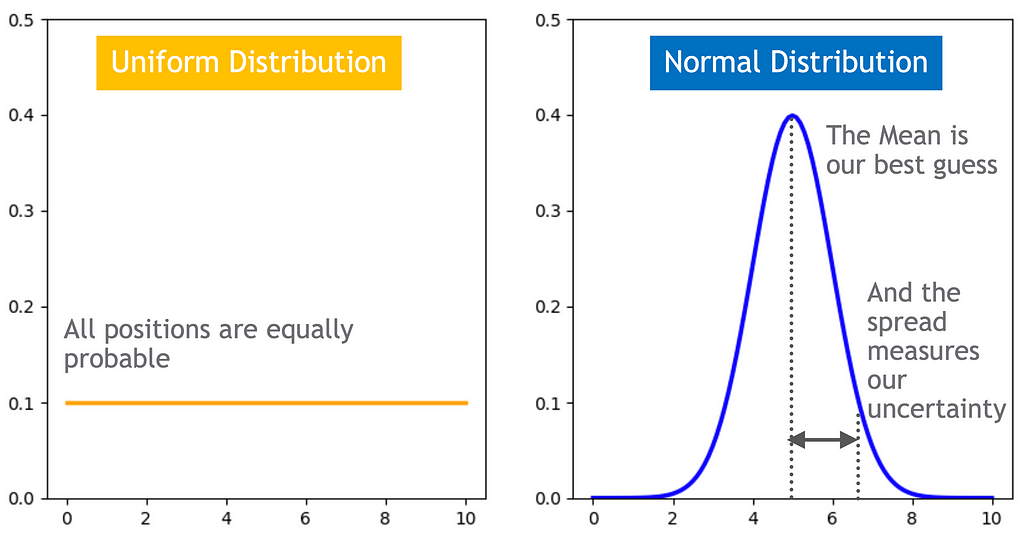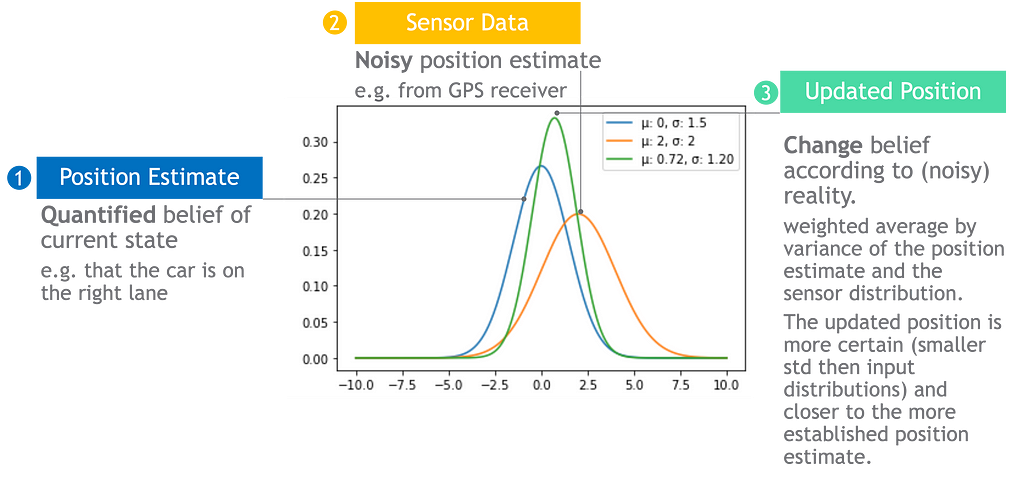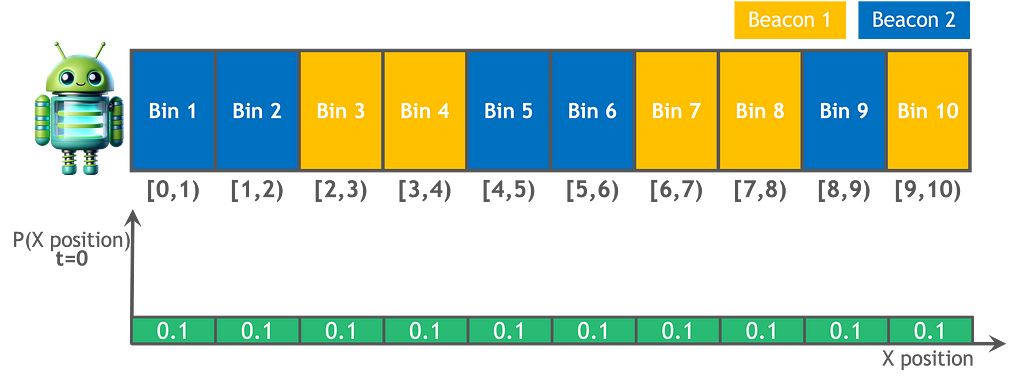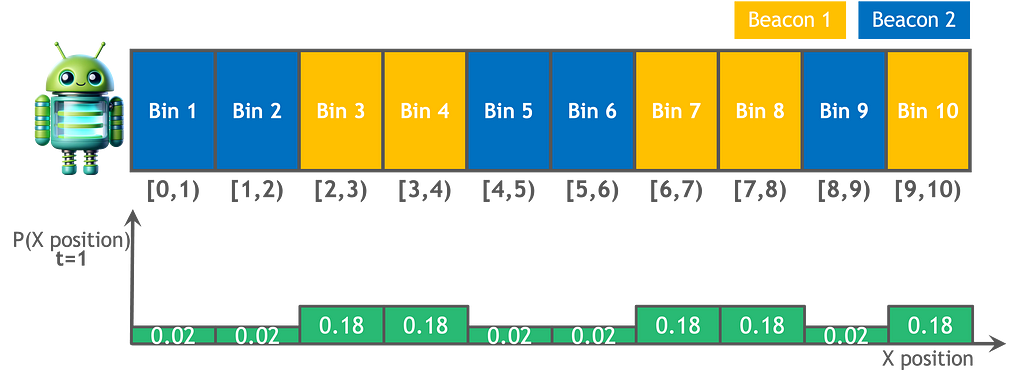The probabilistic method to self-locate below uncertainty
Desk of contents:
- What’s localization and why does a robotic want it?
- Why are probabilistic instruments used to compute localization?
- Finish-to-end instance: how you can use bayesian algorithms to find out a robotic’s place below uncertainty?
How can autonomous vehicles keep inside a single lane at 60mph? How can an i-robot keep away from falling down the steps? How can supply robots know if they’ll the best hungry buyer? These are just some of the questions autonomous autos should reply with out human intervention.
1. What’s localization? And why does a robotic want it?
As you may think, correct automobile location is crucial as to if the autonomous automobile successfully and safely completes its duties. The method to estimate the automobile’s place from sensor information known as localization. Localization accuracy will increase with sensors that add data and reduces with the automobile’s motion which provides noise.
2. Why are probabilistic instruments used to compute localization?
Probabilistic instruments could be leveraged to enhance location accuracy the place neither the sensors nor the motion is 100% correct.
What’s likelihood?
In accordance with the dictionary definition, likelihood is a “numerical description of how doubtless an occasion is to happen” (wikipedia). Nonetheless, in relation to the that means of likelihood, the reply just isn’t that easy. There are rivaling interpretations to likelihood from two main camps, the frequentists and bayesians.
The Frequentist method interprets likelihood because the relative frequency over time; what number of occasions will I get my desired consequence if I repeat an experiment many occasions?
This method is goal as a result of anybody who runs the experiments (e.g. flipping a coin) will get the identical end result within the lengthy run.
The Bayesian method interprets likelihood because the diploma of certainty that an occasion will occur. How sure am I that I’ll get my desired consequence given professional information and the accessible information? This method is subjective, because it represents the present state of perception by combining (subjective) earlier information and experimental information identified thus far. It permits estimating the likelihood of a singular occasion that we are able to’t run many occasions, the place the frequentist that means doesn’t apply.
For instance, if the likelihood {that a} date texts you again after your first meetup is 0.8, then we’re 80% sure that you just had a good time and the individual will textual content you again; we don’t imply they may textual content 80% of the time for those who repeat the primary date again and again once more.
What are the advantages of bayesian likelihood?
Bayesian likelihood permits us to each quantify our diploma of perception and to replace it in gentle of latest proof.
In our context, P(H) is our preliminary guess of the robotic‘s place, and P(H|E) is our up to date guess after measuring the sensors’ proof E.
The speculation likelihood distribution quantifies our certainty within the robotic’s place.

The speculation can change based on proof
The extra informative and correct the sensors information, the larger impact it’s going to have. If the sensor is ideal, the robotic’s place will align with the sensor’s studying, in any other case if the sensor information may be very noisy or non-informative, the robotic’s place will keep the identical.

Updates can mix a number of sources of proof
We are able to formulate Bayes’ legislation to mix a number of information sources by utilizing the chain rule, also called the overall product rule. It permits simplifying a joint distribution of a number of proof to a product of conditional chances.

For instance, we frequently use GPS to navigate from our present location however GPS works finest in clear skies and its accuracy is restricted to a couple meters. Autonomous vehicles can’t solely depend on GPS to stay in a lane that could be a few meters huge and to navigate in tunnels or underground parking tons. Autonomous autos can compensate for GPS deficiencies by including extra sources of knowledge similar to cameras.
3. Finish-to-end instance: how you can use bayesian algorithms to find out the robotic’s place below uncertainty?
Let’s take a deep dive right into a bayesian filter that recursively improves localization likelihood estimates utilizing bayesian inference. The recursive nature signifies that the output of the filter at time t_0, P(H|E), serves because the speculation enter for the subsequent timestamp t_1, P(H).
Suppose a supply robotic is looping a round path inside an area station to move provides. The robotic has a map detailing the lay of the land and the placement of sensors.

– Downside definition:
We confer with the estimated robotic location because the robotic’s state house. For instance, a two-dimensional vector (i.e. an ordered pair of numbers) tracing x-axis place and x-axis velocity can observe a robotic location and altering pace in one-dimension. It’s doable to increase the robotic’s state house to further dimensions to trace a number of place dimensions (y, z), orientation, and so on.
For simplicity, we are able to assume our robotic is transferring with fixed pace. The motion provides uncertainty to the computation, since it isn’t 100% dependable. The engine may fail to run at a particular velocity or the robotic may encounter obstacles, which is able to trigger the robotic to overshoot or undershoot its anticipated motion.
Our robotic will sense its location by measuring the presence of a beacon. The sensor readings, additionally referred to as measurement house, should not 100% correct. Sensors may confuse noise with a beacon sign that may result in false alarms or fail to detect a sign at all.

– The algorithm: histogram filter
With this bayesian filter the robotic state house is represented by a histogram by means of a finite variety of bins or areas. It’s a discrete filter, that means the robotic can solely be in one in all these areas, and we compute the likelihood that the robotic is in every. Moreover, inside every bin, similar to a 5 sq. meter space, the likelihood of being at any particular level is similar. If we need to enhance the granularity, we should add extra bins.
This filter is non parametric, that means it doesn’t make any sturdy assumptions on the robotic’s state illustration, and isn’t restricted to 1 kind of distribution similar to a Gaussian. It is ready to characterize advanced location estimates, similar to a multimodal speculation that retains a number of finest guesses, but it surely comes with a computational price — an exponential complexity. In an effort to add a further dimension, from 1-D to 2-D whereas preserving the identical granularity, we’ll want 10×10 bins, to maneuver to 3-D we’ll want 10x10x10 bins, and so forth. This can be a vital limitation for robots that observe a number of dimensions and are restricted in reminiscence and compute energy.
– Calculation:
- Preliminary guess: We begin from an unknown location geared up with a map. At first each area is equally possible, as represented by a uniform distribution throughout all bins.

2. Motion operate: simulates the robotic motion. The robotic’s movement is stochastic, that means it isn’t assured to maneuver to the specified bin at every time step. To replace the robotic’s location after every transfer, we calculate the likelihood of the robotic being in every area on the subsequent time step. This calculation considers each the likelihood of the robotic to remain in the identical area and the likelihood of it to maneuver to a unique area.
For every motion:
For every area:
Area likelihood at time t+1 =
Area likelihood at time t x keep likelihood +
Chance of robotic coming from the neighboring area x transfer likelihood

As proven within the equation beneath, the robotic’s one-step motion is not going to change the placement estimate due to the uniform distribution, the place every area has equal likelihood to remain and transfer.

Even when we initially start at a bin with full certainty (100%), the inherent randomness in motion will step by step add noise, main us in direction of a uniform distribution over time. We have to add data!
3. Sense operate: incorporates measurements that add data utilizing Bayes’ theorem.
After every motion:
For every area:
Area likelihood at time t+1 given measurement at time t+1 =
Chance of the measurement given the robotic is in that area
x Area likelihood at time t+1 after motion
x normlization to make sure that all the possibilities sum to 1.
The sensors reliability is represented with chances, since they aren’t 100% correct. The equations beneath reveal that when the sensor detects the colour orange, there’s a 90% likelihood that the robotic is situated in an orange bin, and a ten% likelihood that the sensor is unsuitable and the robotic is definitely in a blue bin.

The calculation introduced beneath illustrates that, in distinction to motion, sensors contribute data and enhance our understanding of the robotic’s location. As an illustration, as a result of bin 2 just isn’t orange, the likelihood of the robotic being in it diminishes from 0.1 to 0.02.

The picture beneath reveals the up to date location speculation after incorporating motion and sensors’ information to our preliminary guess.

Closing ideas
The place is the robotic? We are able to constantly refine our reply to this query by utilizing recursive bayesian filters, ranging from a uniform distribution that retains all guesses equally possible till deciding on the almost certainly one.
Bayesian filters assist us measure our confidence within the robotic’s whereabouts, updating this perception by integrating (noisy) sensor information with prior data (the estimated robotic’s place after motion).
Sources:
- These are my abstract notes from the primary lectures of the extremely suggest edX course “Bayesian algorithms for Self-Driving Autos” by Dr.Roi Yozevitch.
- Probabilistic Robotics GitBook: Non parametric filter
- Wikipedia likelihood, likelihood principle and bayes theorem
- Daniel Sabinasz’s private weblog on histogram filters
- On-line converter from latex to png.
- Pictures: the robotic avatar was created with Dall-E. All different photos used on this article had been created by the creator.
The way to end up in a digital world? was initially printed in In the direction of Knowledge Science on Medium, the place persons are persevering with the dialog by highlighting and responding to this story.


